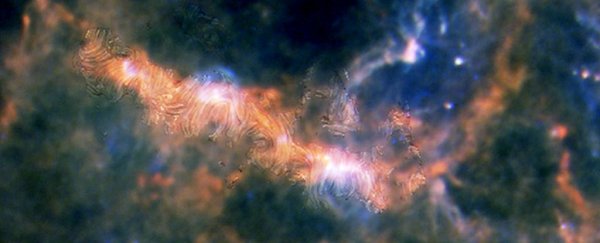For the first time, scientists have completely mapped one of the 'bones' of the Milky Way galaxy.
That bone is a long, dense filament of cold gas in the densest part of one of the galaxy's spiral arms. It measures around 195 light-years in length; the map, acquired using the Stratospheric Observatory for Infrared Astronomy (SOFIA) plane, gives us the first complete picture of the magnetic fields therein.
The result defies expectations. Rather than aligned along the length of the bone, the magnetic fields are more higgledy-piggledy, and the average magnetic field is neither parallel nor perpendicular to the bone. This, the researchers said, can help us to better understand not just the structures of spiral galaxies, but their star formation.
"Before SOFIA, it was difficult to image magnetic fields at high resolution over the entirety of the bones," said astrophysicist Ian Stephens of Worcester State University, Massachusetts.
"We are now able to get so many independent measurements of the magnetic field direction across these bones, allowing us to really delve into the importance of the magnetic field in these massive filamentary clouds."
Scientists first identified one of the Milky Way's bones back in 2013; since then, they've found 18 of these galactic bones in total. Our galaxy currently has a pretty low rate of star formation, around three solar masses per year; however, what star formation does take place tends to do so in these so-called bones.
Just as your bones are the densest part of your arms, so too are galactic bones the densest part of the Milky Way's arms. The defining properties of these bones are that they must be at least 50 times longer than they are wide, and be close and mostly parallel to the galactic plane.
Astronomers have also conducted thorough measurements of their size, mass, temperature, altitude, and density.
However, the magnetic fields of said bones have been poorly constrained. Stephens and team have made use of SOFIA, a modified Boeing that flies above Earth's stratosphere to avoid infrared interference, to take measurements of 10 of the bones. The first of these is G47.
"Magnetic fields…can potentially set the rate at which stars form in a cloud. They can also guide the flow of gas, shape the bones, and affect the quantity and size of the densest pockets of gas that will eventually collapse to form stars," Stephens said.
"By mapping the orientation of the fields, we can estimate the relative importance of the magnetic field to that of gravity, to quantify how much magnetic fields affect the star formation process."
The team used SOFIA to take observations of the infrared light emitted by dust in G47. Non-spherical dust grains align along the direction of the magnetic field, which can be detected in the polarization of the infrared light they emit. Researchers can use that polarization to map the orientation of magnetic field lines within a volume of space.
The study revealed that the magnetic fields are sometimes, but often not, perpendicular to the center of the bone. Those regions with perpendicular magnetic fields tend to be the regions that are the densest – with the most active star formation.
In other regions, the magnetic fields are either parallel or randomly aligned. Those regions are where the magnetic field appears to be strongest against the gravitational collapse of the bones; the star formation regions are the weakest against gravitational collapse, the researchers said.
This suggests that magnetic fields play a role in keeping the G47 bone from collapsing, and shaping the bone in the higher density regions. However, the magnetic fields in the lower density regions are complicated and messy, and the role the magnetic field plays is unclear.
Since G47 was just the first in a series of in-depth studies of the magnetic fields of galactic bones, the remaining work may help resolve this mystery. The first look has been tantalizing for sure.
The research has been published in The Astrophysical Journal Letters.
